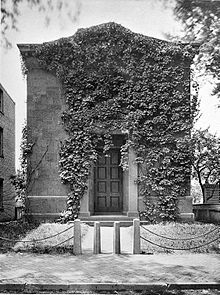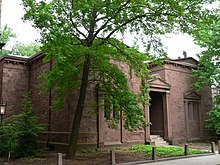| Skull and Bones |

The emblem of Skull and Bones
|
| Founded |
1832; 192 years ago
Yale University |
| Type |
Secret society |
| Affiliation |
Independent |
| Status |
Active |
| Scope |
Local |
| Chapters |
1 |
| Members |
2,800+ lifetime |
| Nickname |
Bones
The Order
Order 322
The Brotherhood of Death |
| Headquarters |
64 High Street
New Haven, Connecticut 06511
United States |
Skull and Bones, also known as The Order, Order 322 or The Brotherhood of Death, is an undergraduate senior secret student society at Yale University in New Haven, Connecticut. The oldest senior-class society at the university, Skull and Bones has become a cultural institution known for its powerful alumni and various conspiracy theories.
Skull and Bones is considered one of the "Big Three" societies at Yale University; the other are Scroll and Key and Wolf's Head.[1] The society is known informally as "Bones", and members are known as "Bonesmen", "Members of The Order" or "Initiated to The Order".[2]

The tomb before the addition of a second wing

A 2009 view of the tomb from across High Street
Skull and Bones was founded in 1832 after a dispute among Yale debating societies Linonia, Brothers in Unity, and the Calliopean Society over that season's Phi Beta Kappa awards.[3] William Huntington Russell and Alphonso Taft co-founded "The Order of the Skull and Bones".[3][4] The first senior members included Russell, Taft, and thirteen other members.[5] Alternative names for Skull and Bones are The Order, Order 322 and The Brotherhood of Death.[6]
The first extended description of Skull and Bones, published in 1871 by Lyman Bagg in his book Four Years at Yale, noted that "the mystery now attending its existence forms the one great enigma which college gossip never tires of discussing."[7][8]
In a 1974 book, Brooks Mather Kelley attributed the interest in Yale senior societies to the fact that underclassmen members of then freshman, sophomore, and junior class societies returned to campus the following years and could share information about society rituals, while graduating seniors were, with their knowledge of such, at least a step removed from campus life.[9]
Since its founding, Skull and Bones annually selects 15 members of the junior class to join the society.[10] Skull and Bones selects new members among students every spring as part of Yale University's "Tap Day", and has done so since 1879. It taps those that it views as campus leaders and other notable figures for its membership.
In the 1960s, secret societies adapted in response to criticism for elitism and discrimination. Skull and Bones admitted its first black member in 1965, and the president of Yale's gay student organization in 1975.[11]
Yale became coeducational in 1969, prompting some other secret societies such as St. Anthony Hall to transition to co-ed membership, yet Skull and Bones remained fully male until 1992. The Bones class of 1971's attempt to tap women for membership was opposed by Bones alumni, who dubbed them the "bad club" and quashed their attempt. "The issue", as it came to be called by Bonesmen, was debated for decades.[12]
The class of 1991 tapped seven female members for membership in the next year's class, causing conflict with the alumni association.[13] The trust changed the locks on the Tomb and the Bonesmen instead met in the Manuscript Society building.[13] A mail-in vote by members decided 368–320 to permit women in the society, but a group of alumni led by William F. Buckley obtained a temporary restraining order to block the move, arguing that a formal change in bylaws was needed.[13][14] Other alumni, such as John Kerry and R. Inslee Clark, Jr., spoke out in favor of admitting women. The dispute was highlighted on an editorial page of The New York Times.[13][15] A second alumni vote, in October 1991, agreed to accept the Class of 1992, and the lawsuit was dropped.[13][16][17]
In recent years, Skull and Bones, like other elite Yale institutions, "utterly transformed", according to The Atlantic. The society tapped its first entirely non-white class in 2020. Few descendants of alumni get in, and progressive activism is an asset. The class of 2021 admitted no conservatives.[11]
Symbols and traditions
[edit]
The society's badge is gold and consists of a skull that is supported by crossed bones, with the number 322 on the lower jaw.[10] Its members worshipped Eulogia, a fictional goddess of eloquence.[18]
The number "322" appears in Skull and Bones' insignia and is widely reported to be significant as the year of Greek orator Demosthenes' death.[16][19][5] A letter between early society members in Yale's archives[20] suggests that 322 is a reference to the year 322 BC and that members measure dates from this year instead of from the anno domini. In 322 BC, the Lamian War ended with the death of Demosthenes and Athenians were made to dissolve their government and establish a plutocratic system in its stead, whereby only those possessing 2,000 drachmas or more could remain citizens. Documents in the Tomb have purportedly been found dated to "Anno-Demostheni."[21]
One legend is that the number represents "founded in '32, 2nd corps", referring to a first Corps in an unknown German university.[22][23] Another possible reference of 322 is the Freemasonic Lodge of Virtue and Silence no. 322, in Suffolk, UK, signaling a fraternal but unspoken sponsorship between the two "secret society" organizations, regarding which silence is considered virtuous. Lodge 322 was founded in 1811,[24] 21 years before the creation of the Skull and Bones association in 1832.

